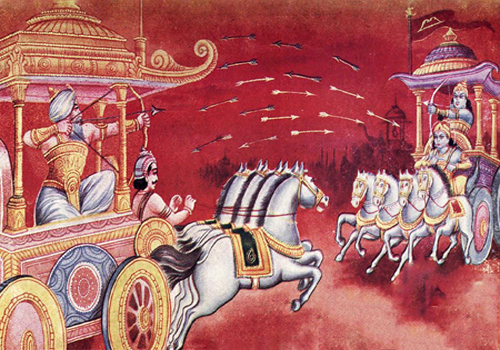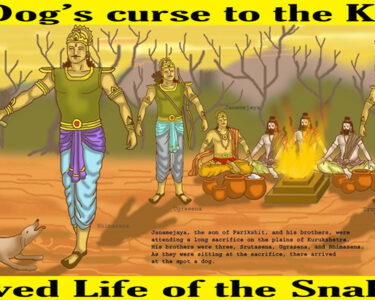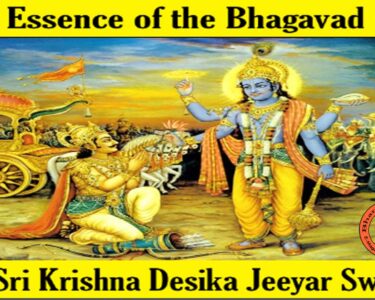SRIMAD MAHABHARATA > AADI PARVA > SANGRAAHA PARVA > CHAPTER 2(D)
(BRIEF OF BHISHMA PARVA)
“Soota continued, “Then is recited the Bhishma Parva filled with wonderful incidents. In this has been narrated by Sanjaya the formation of the region known as Jambu (Jambudweepa in Sanskrit). Here has been described the great depression of Yudhishthira’s army, and also a fierce fight for ten successive days. In this the high-souled Vaasudeva (Sri Krishna) by reasons based on the philosophy of final release (Moksha in Sanskrit) drove away Arjuna’s uneasiness springing from the latter’s (Arjuna’s) regard for his relations (whom he was on the eve of slaying) (popularly known as Srimad Bhagavad Gita).
“In this the magnanimous (Sri) Krishna, attentive to the welfare of Yudhishthira, seeing the loss inflicted (on the Paandavaa army), descended quickly from his chariot Himself and ran, with fearless chest, His driving whip in hand, to achieve the death of Bhishma. In this, (Sri) Krishna also striked with piercing words Arjuna, the bearer of the Gandiva and the foremost in battle among all wielders of weapons.
“In this, the foremost of bowmen, Arjuna, placing Shikandi before him and piercing Bhishma with his sharpest arrows felled him from his chariot. In this, Bhishma lay stretched on his bed of arrows.
“This extensive Parva is known as the sixth in the (Maha)Bharata. In this have been composed one hundred and seventeen (117) sections. The number of shlokas is five thousand, eight hundred and eighty-four (5,884) as told by Vyaasa knowledgeable with Vedas.
(BRIEF OF DRONA PARVA)
“Then is recited the wonderful Parva called Drona full of incidents. First comes the installation in the command of the (Kauravaaa) army of the great instructor in arms, Drona; then the vow made by that great master of weapons (Drona) of seizing the wise Yudhishthira in battle to please Duryodhana; then the retreat of Arjuna from the (battle)field before the Samshaptakas, then the overthrow of Bhagadatta like to a second Indra in the (battle)field, with the elephant Supritika, by Arjuna; then the death of the hero Abhimanyu in his teens, alone and unsupported, at the hands of many Mahaarathaas including Jayadratha; then after the death of Abhimanyu, the destruction by Arjuna, in battle of seven Akshauhinis of troops (153,090 chariots; 153,090 elephants; 459,270 cavalry; 765,450 infantry) and then of Jayadratha; then the entry, by Bhima of mighty arms and by that foremost of warriors-in-chariot, Saatyaki, into the Kauravaaa ranks impenetrable even to Devas, in search of Arjuna in obedience to the orders of Yudhishthira, and the destruction of the remaining of Samshaptakas.
“In the Drona Parva, is the death of Alambusa, of Srutayus, of Jalasandha, of Somadatta, of Viraata, of the great warrior-in-chariot Drupada, of Ghatotkacha and others; in this Parva, Ashwatthaama, excited beyond measure at the fall of his father in battle, discharged the terrible weapon Narayana. Then the glory of Rudra in connection with the burning (of the three cities). Then the arrival of Vyaasa and recital by him of the glory of (Sri) Krishna and Arjuna.
“This is the great seventh Parva of the (Maha)Bharata in which all the heroic chiefs and princes mentioned were sent to their account. The number of sections in this is one hundred and seventy (170). The number of shlokas as composed in the Drona Parva by Rishi Vyaasa, the son of Paraashara and the possessor of true knowledge after much meditation, is eight thousand, nine hundred and nine (8,909).



